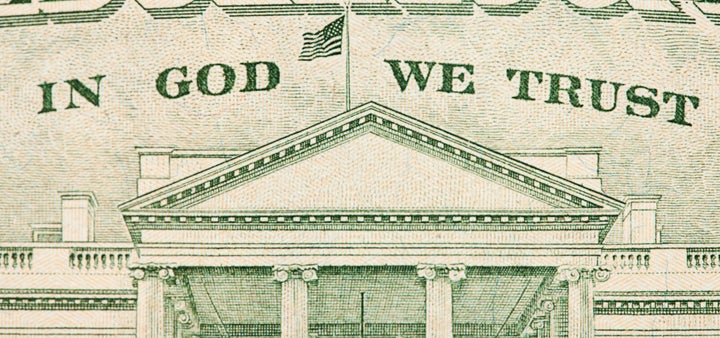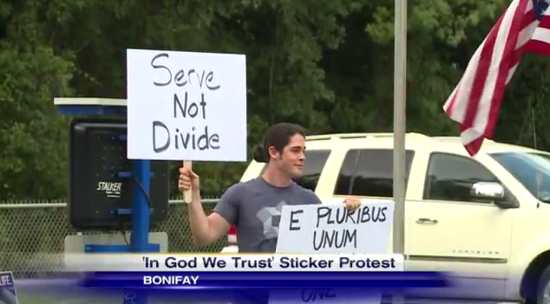
You may recognize the phrase “In God We Trust” if you’ve ever taken the time to examine a coin or the back of that crumpled up bill in your pocket. Those four words are printed on all U.S. currency and they serve as our official national motto, but there is also a deeper story behind their rise to icon status.
The Liberty Bell has long been surrounded by origin myths and stories, such as George Lippard’s fabricated account of how it first rang on July 4, 1776 to celebrate the Declaration of Independence [1], which started its reputation as a beacon of American liberty. Unlike the Bell, however, the national motto of “In God We Trust” has a clear and factual beginning to its story. According to the U.S. Department of the Treasury, during the Civil War era there was a significant increase in religious conviction among Americans, many of whom wrote to the Secretary of the Treasury Salmon P. Chase and called for some federal recognition of God on U.S. currency in light of the ongoing division and destruction of the war. [2]
In 1863 Secretary Chase and the Mint at Philadelphia (yet another Philadelphia connection among icons!), came up with the designs for new one-cent, two-cent, and three-cent coins and created the saying “In God We Trust,” and the next year Congress passed a Coinage Act that allowed the phrase to appear on the two-cent coin. [3] Subsequent acts were passed and by 1909 it was printed on all minted U.S. coins. Interestingly enough, “In God We Trust” was the national motto until 1956, when President Dwight D. Eisenhower approved a Joint Resolution that declared it so. It first appeared on paper money in 1957 and it was added to the currency production process. And from 1966 on, every coin and every printed federal reserve note has had the motto printed on it. [4]

I chose to compare the Liberty Bell and “In God We Trust” because although they may be different in physical nature and separated by almost a century of history, both have been (and one still is) the subject of controversy about their respective values of freedom and faith. The presentation of the Liberty Bell as a symbol of American independence has been questioned and subverted many times throughout history, starting with Bostonians and New Yorkers who appropriated it as an emblem of the abolitionist movement in the 1830s and 1840s. They spoke out against the irony of the Liberty Bell promoting freedom for all while there was still a significant enslaved population in Philadelphia and across America. [5]
A similar conflict arose surrounding plans for a new pavilion and visitors’ center for the Liberty Bell at Independence National Historical Park in the early 2000s that placed the site adjacent to the former President’s House, where George and Martha Washington kept slaves. [6] [footnote Titus] As Jill Ogline Titus writes, the battle between INHP and many different city groups and historians to recognize the slave quarters and include interpretive material at the Liberty Bell Center would fundamentally change the experience for visitors. “When viewing it will require visitors to cross the foundations of rooms in which enslaved Africans waited upon white revolutionaries, interpreters of the Liberty Bell will have the opportunity to transcend the object and interpret something much bigger.” [7] [footnote Titus]
This internal conflict about the true nature of an American icon is also applicable to “In God We Trust”; for strong believers in the separation of church and state and atheist activists, the inclusion of God in the national motto is a problem. Eisenhower, who successfully lobbied for the inclusion of God in the Pledge of Allegiance in 1954, stated that it was reaffirming “the transcendence of religious faith in America’s heritage and future.” [8] Since then, those who feel otherwise have tried to make their voices heard, from filing court cases arguing that the motto places Christians above atheists or other religions to protesting the use of the motto on local sheriff and police vehicles in communities across the United States. [9] In the cases of the Liberty Bell and the national motto, one might ask: What are the implications of the federal government endorsing an icon without properly acknowledging that some groups of Americans are excluded from its meaning and its protections? “In God We Trust” falls under the increasingly fractured line that separates religion and government in this country. Maybe it’s time to take a second look at this American icon.

—————————————–
1. Nash, Gary B. The Liberty Bell, 40. New Haven: Yale University Press, 2011.
2. “History of ‘In God We Trust’.” U.S. Department of the Treasury. March 8, 2011. https://www.treasury.gov/about/education/Pages/in-god-we-trust.aspx.
3. Ibid.
4. Ibid.
5. Nash, 35-39.
6. Titus, Jill Ogline. “‘Creating Dissonance for the Visitor’: The Heart of the Liberty Bell Controversy.” The Public Historian 26, no. 3 (2004): 49-58. doi:10.2307/3379448.
7. Ibid.
8. Hallowell, Billy. “Here’s the deep history behind ‘In God We Trust’.” Deseret News. August 02, 2016. https://www.deseretnews.com/article/865659185/Heres-the-deep-history-behind-In-God-We-Trust.html.
9. Ibid.